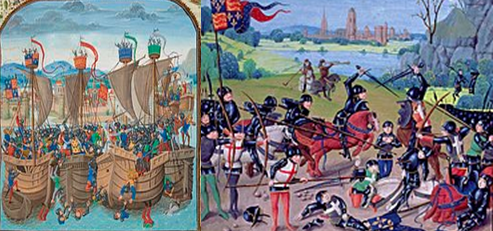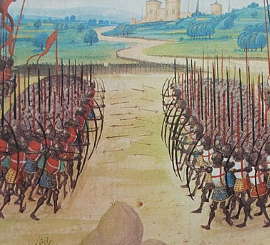Hundred Years’ War: History, Timeline, & Facts
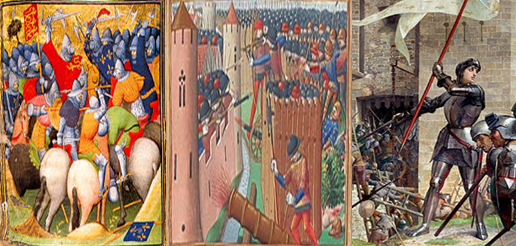
Hundred Years’ War – History and Timeline
Wholeheartedly believing that his French parentage entitled him to be the rightful king of France, Edward III of England made a public claim to all of French lands. Edward’s 1327 proclamation quickly turned an already frosty relationship between France and England into a series of fierce, bloody battles that spanned from 1337 to 1453. The sum total of those fierce battles between those two European nations for the French crown is what constitutes the Hundred Years’ War.
In the article below we take a look at the history, dates, timeline, and some notable facts about the Hundred Years’ War:
The Three Phases of the Hundred Years’ War
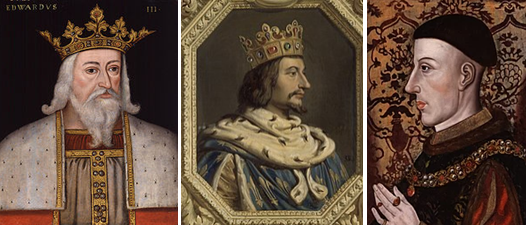
Hundred Years’ War Phases. Image (L-R): Edward III of England, Charles V of France, Henry V of England
First of all, it must be noted that although the war is labeled as Hundred Years, the war in fact spanned about 116 years, from 1337 to 1453. So why do historians refer to it as the Hundred Years’ War? It was used by people of the time because the war stretched for an unreasonably long period.
Secondly, the Hundred Years’ War did not rage continuously for the entirety of the 116 years. Instead it was fought in phases with periods of relative peace between France and England. Waging war has and will always be a very a financially draining human endeavor. Obviously the two nations at some point in that period would have had tremendous difficulties raising money to wage the war. In some cases, those relative peaceful patches were the result of an arranged marriage between the two warring houses. A case in point was in 1396 when Richard II of England of the House Plantagenet married Isabella of Valois, the daughter of Charles VI of France.
As result of the above, historians generally put the Hundred Years’ War into three phases, with each phase reflecting the dominant monarch or house of the period. For example the Edwardian War (1337-1360) is named after Edward III of England, the monarch whose Aquitaine territory in France was seized by Philip VI of France. Adding more insult to injury, Philip VI launched an attack on the southern coast of England. At that point, Edward did not much justification to go to war with France. The English monarch declared himself king of France in 1340 before going on to have a very successful campaign against Philip, including victories at the Battle of Auberoche (1345), the Battle of Crecy (1346), and the Battle of La Roche-Derrien (1347). Edward’s success continued after the mid-1350s break (as a result of the Black Death), winning at the Battle of Poitiers (1356). The Edwardian chapter of the Hundred Years’ came to a conclusion with the Treaty of Brétigny in 1360.
Then there is the Caroline War, which spanned from 1369 to 1389, that reflects the reign of Charles V of France who renewed the Hundred Years’ War nine years after the Treaty of Brétigny. Also known as Charles the Wise, Charles V’s reign (1364-1380) ushered in a period great success for France in the Hundred Years’ War. With sound and very capable advisors in his court, Charles was able to reconquer many of the territories that were lost by his predecessors to England.
The Lancastrian War phase (1215-1253) reflects the ascendancy of England under the reign of Henry V of England (from 1413 to 1422), who was from the House of Lancaster (1362-1471). The first half of this chapter saw England completely dominate their arch enemies France, with glorious wins at the Battle of Agincourt (1415) and securing many political concessions from the ineffectual Charles VI of France. However, in the second half of the Lancastrian War, France made a huge comeback following the arrival of French peasant girl Joan of Arc, a woman whose divine visions helped lift the spirits of Charles VII of France’s army. By 1453, England had lost virtually all of its continental territories in France, except the Pale of Calais.
Events that precipitated the War
1325: Charles IV makes peace with Edward II of England by returning Aquitaine territory in France to England.
1327: Charles IV of France dies without any sons or brothers to succeed him.
1327: Charles IV’s patrilineal cousin Philip, Count of Valois, is crowned Philip VI, king of France.
1329: Edward III reluctantly pays a half-hearted homage for his French fiefs – duchy of Aquitaine and Guscony in France – to his rival Philip VI of France.
Timeline of the Hundred Years’ War
1337: After consulting with his Great Council in Paris, Philip VI confiscates Edward’s territory of Gascony in France and proceeds to attack the southern coast of England.
1337: Edward III of England lays claim to the French throne. He would later take the title King of France and add the French royal coat of arms (the fleur-de-lys) to his in 1340.

Edward III sheltered Robert d’Artois, an enemy of Philip VI who had been accused of forgery in France. Image: Edward III of England as head of the Order of the Garter, drawing c. 1430–40 in the Bruges Garter Book
1340: Edward goes into an alliance with noblemen and counts of the Low Countries (today’s Netherlands and Belgium), while Philip seeks help from Scotland and Castile.
1340: The Avignon Papacy gives its thumbs up to the Salic law and supports the coronation of Philip VI.
1340: Battle of Sluys sees Edward III secure control of the waterways between England and France. This allows him to dominate the English Channel as well as sail his naval fleet to the shores of France.
1346: Edward lII makes a landing in Normandy in July with over 10,000 men. With French army pushed back, Edward and his make camp near Crecy before annihilating every French force that was thrown his way at the Battle of Crecy.
1346: David II of Scotland’s attempt to distract England by attacking northern England ends in a loss; the Scottish king is captured at the Battle of Neville’s Cross on 17 October.
1347: At the Battle of Calais English forces lay siege to the French city of Calais; the result is a big a victory for Edward III of England.
1348-1353: The deadly and population-devastating Black Death sweeps through Europe, leaving a significant portion of the Europe’s population dead. The severity of the plague causes hostilities between England and France to subside, as about one third of England’s population is wiped of the face of the earth. France is neither sparred, losing about 25% of its population to the plague.
Did you know: Calais remained an English territory until 1558?
Edward the Black Prince’s Chevauchée and the Battle of Poitiers in 1356
Following Europe’s recovery from the Black Death, hostilities between England and France resumes with raids in France led by Edward the Black Prince, son of Edward III.
1355: After raising some amount of money, English forces, led by Edward III’s son Edward the Black Prince, conducts a chevauchée in France, pillaging and plundering many places, including Avignonet, Carcassonne, Narbonne, and Castelnaudary.
1356: At the Battle of Poitiers, King John II of France nearly secures a victory over Edward’s army, but for a quick counterattack by the English. The French line collapses and France suffers heavily. King John II is captured by English forces, along with more than 1800 French soldiers and aristocrats.
1360: Edward’s forces win big at Sluys and take control of large parts of northern France

Following the capture of John II of France by English forces, many French nobles and mercenaries go on rampage and are discontented with the way the French monarchy is handling the war. England imposes a steep ransom for King John II. The ransom amounted to about one third the size of the French economy at the time
Black Monday at Easter (1360) and the Peace Treaty of Brétigny
1360: After a failed siege attempt on the city of Paris, Edward and his army is forced to leave Paris. While camped outside the gates of the French city of Chartres, more than 1,000 English men die during a hailstorm in the middle of April.
May, 1360: At Brétigny, Edward signs a peace treaty with the French on May 8. As part of the treaty, Edward’s lands in Aquitaine would increase in exchange for his renouncement of his claims to Touraine, Anjou, Normandy and Maine.
1362: With one John II of France’s son escaping from English captivity, John II had to return to England.
1364: John II dies while being held captive in London, England. John’s son, the dauphin Charles (Charles V), succeeded him to the throne on May 16.
May 16, 1364: Newly crowned French king Charles V defeats Charles II of Navarre at the Battle of Cocherel.
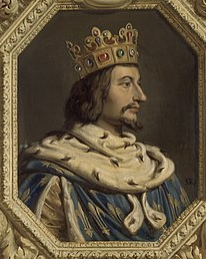
The 1360s and 1370s were periods of great battle victories for France against England. Under the reign of Charles V of France, the French troops had wind in their sails, as they were able to reconquer many of territories lost during the Edwardian Phase of the Hundred Years’ War. Image: Charles V, dit le Sage, roi de France (1838) by Gillot Saint-Evre
Resumption of hostilities
1369: Hostilities between England and France return due Edward the Black Prince’s attempt to increase taxes in Aquitaine was opposed by a local lord called Arnaud-Amanieu VIII.
1372: At the Battle of La Rochelle, Castilian fleet, under the newly crowned Castilian monarch Henry of Trastámara, destroys English fleet.
Deaths of Edward III and Edward the Black Prince
The deaths of King Edward III and his son Edward the Black Prince put England in a bad position since the successor to Edward III, Richard II is only 10 years old. Charles V of France and Commander Bertrand du Guesclin take advantage of the deaths and continue taking back many of the lands won by King Edward III of England.
1373: Edward III’s third son John of Gaunt heads down south with about 9,000 soldiers to conduct chevauchée.
1376: Edward the Black Prince, oldest son of Edward III, dies on June 8. Edward is succeeded by his second son Richard.
1377: King Edward III of England dies on June 1377.
Reign of Charles VI of France and the loss of French momentum
Deaths of Charles V and Bertrand du Guesclin swing the momentum in favor of England. Charles V’s successor Charles VI was relatively young at the time of ascending to the throne. His inability to re-impose taxes on the population affected his war efforts against England. Upon attaining the age of majority, his reign ended up being a calamitous one as he suffered severely from mental illness. Power was effectively in the hands of his uncles and his wife Queen Isabeau of Bavaria.
Many power hungry factions appeared in France. For example, John the Fearless, Duke of Burgundy, who is said to have ordered the murder of Louis I of Orléans in 1407 in order to exert more influence on the mentally unstable Charles VI.
The death of the King’s brother notched France into a civil war fought between Duke of Burgundy and the French royal family. The conflict would continue until 1435, when the Treaty of Arras was signed.
1380: Charles V of France and Bertrand du Guesclin pass away. Charles V’s 11-year-old son Charles VI is crowned king of France on November 4.
1381: Fierce opposition to the poll tax results in a revolt called the Peasants’ Revolt grips England. The revolt is led by Wat Tyler. Richard II, with the help of English nobleman Henry Despenser, quickly puts down the revolt in late June.
1381: The Duke of Brittany allies (under the Treaty of Guérande) with Charles VI of France.
Richard II of England is deposed by his cousin Henry of Bolingbroke
1388: John of Gaunt, an uncle of Richard II of England and the power behind Richard II’s reign, returns to England.
1389 – France and England struck a peace treaty
1392: French King Charles VI’s mental illness gets worse and regents are appointed to rule in his stead.
1399: John of Gaunt, one of the trusted advisors of Richard II of England, dies. Richard II of England then exiles his cousin Henry Bolingbroke, son of John of Gaunt.
1399: Henry Bolingbroke returns to England with a large army and deposes Richard II. Henry crowns himself Henry IV.
1400: While held captive in Pontefract Castle by usurper King Henry IV, deposed King Richard II passes away at the age of 33.
1410: The Burgundians take control of Paris.
1413: Henry IV dies and is succeeded by his eldest son Henry V.
Battle of Agincourt (1415) and the Treaty of Troyes in 1420
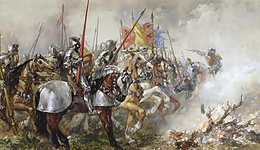
Following England’s magnanimous victory over France at the Battle of Agincourt, Henry V of England gets France to make a number of political and economic concessions. Charles VI of France disinherits his son the Dauphin (later Charles VII) and makes Henry V his heir. Image: King Henry V at the Battle of Agincourt, 1415, by Sir John Gilbert in the 19th century.
1415: Henry V sails to France with an army of about 11,000 men. He would go on to defeat French forces about three times his forces at the Battle of Agincourt.
1417-1419: Large parts of Normandy, Caen and Rouen are taken by Henry V.
1420: The Treaty of Troyes is signed between Charles VI and Henry V. As part of the treaty, Henry V married Catherine of Valois, daughter of Charles VI.
Deaths of Henry V and Charles VI
1421: Henry V’s brother and then heir presumptive Thomas, Duke of Clarence is killed at the Battle of Baugé.
1422: Henry V dies (possibly dysentery) on August 31. He was succeded by his infant son Henry (later Henry VI).
1422: Charles VI of France passes away on October 21.
1424: English-Burgundian forces secure victory over Franco-Scottish forces at the Battle of Verneuil near Verneuil-sur-Avre in Normandy.
France gets her spirits lifted by the appearance of Joan of Arc
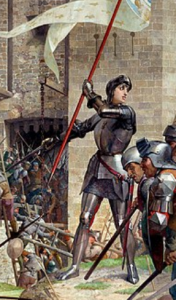
France, under the inspiration of Joan of Arc, go on a winning streak, retaking many French cities in the possession of England, including the Loire and Patay.
1428-1429: The arrival of Joan of Arc lifts French forces spirits and the Siege of Orleans by England and its French allies comes to an end.
1429: Charles VII is crowned at the Cathedral of Reims on July 16.
1430: During a campaign at Compiègne in northern France, Joan of Arc is captured by pro-English Burgundian forces and then handed over to the English.
1431: Joan of Arc is burned at the stake after she is found guilty of heresy by an English court.
Henry VI of England’s reign and ultimate loss
1431: After his coronation ceremony as King of England at Westminster Abbey in 1429, Henry VI is crowned king of France at Notre-Dame in Paris on December 16, 1431.
1435: Philip the Good, duke of Burgundy, makes peace with Charles VII with the Treaty of Arras.
1450: French troops secure victory over English forces at the Battle of Formigny.
1451: English-held Gascony province surrenders to Charles VII’S forces on June 30.
1453: France emerges the victor at the Battle of Castillon in July 17; three months later France took possession of Bordeaux.
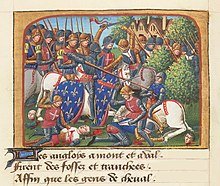
Hundred Years’ War – The Battle of Formigny (1450)
Aftermath of the war
The Battle of Castillon is largely considered as the last violent confrontation between England and France in the Hundred Years’ War. Although curtain was drawn on the war, England and France remained formally at war for another two decades or so. Besides, England had its hand full as it had to deal with a brewing unrest within its borders. England’s loss of its continental lands was a bitter pill to swallow for many English landowners and barons who felt a lot of money had simply gone down the drain. As a result, England had to contend with a civil war – the Wars of the Roses – which started in 1455.
After receiving quite a hefty compensation from the French monarch, Edward IV of England renounced his claim to the French throne. Thus the Treaty of Picquigny in 1475 formally brought an end to the Hundred Years’ War.
More Facts
Tensions between England and France started long before the Hundred Years’ War. Often times, those tensions were due to territories owned by English royal family in France. Due to the fact that English royal family traced its roots to some France, English monarchs were eligible to hold lands and titles in France. What this meant was that some French kings compelled English monarchs’ lands in France to act as vassals to the French kings.
It was also not uncommon for French kings to seize lands owned by English monarchs within France. Sometimes this the French kings’ way of flexing their power, or in some cases, it was a way for the French kings to get political concessions from England.
The House of Capet went extinct following the death of a childless Blanche of France, the only daughter of King Charles IV of France, in 1393.
A rule in France, probably based on the ancient Frankish civil law code called the Salic law, did not allow women to inherit the French throne. The law also forbade inheritance through female line. As a result of this rule, Philip VI of France became king instead of Edward III of England.
The English longbow – extremely pivotal in the war, especially during the Battle of Agincourt – the bow could release the arrow faster and farther than the French crossbow.
One of the significant effects of the Hundred Years’ War on France was that it allowed France to move away from a group of lose alliance of feudal lands to a national government.
Joan of Arc was canonized on May 16, 1920 by Pope Benedict XV. Her feast day is May 30. She is one of the nine secondary patron saints of France.
